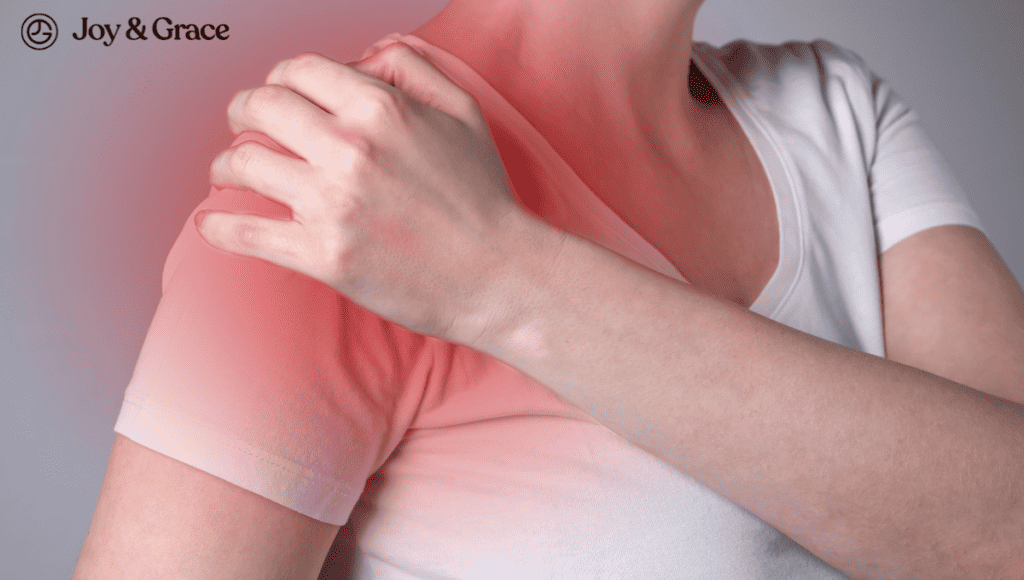Have you ever caught yourself rubbing the tip of your shoulder, feeling it throb, and wondering, "What's going on?"
Shoulder tip pain can signify a myriad of issues. Some are deeply rooted in our body's intricate anatomy and can heavily impact our overall well-being. Let's explore this pain together and find some relief.
What Causes Pain At The Tip Of The Shoulder?
Pain at the tip of your shoulder is most commonly linked to acromioclavicular (AC) joint problems. The AC joint is located at the top of your shoulder, where your collarbone (clavicle) meets part of your shoulder blade called the acromion.
A lot of conditions can affect the acromioclavicular joint. According to a study, the following are the most common:
- Trauma
The acromioclavicular joint is particularly susceptible to trauma. Trauma to the AC joint is often referred to as an AC joint injury or separation.
According to a journal article, 40% of all shoulder injuries are AC joint injuries. AC joint injuries also account for 10% of all collision sports-related injuries.
Trauma can result from various causes, such as sports-related injuries, falls, or motor vehicle accidents. These injuries typically involve a disruption of the ligaments and soft tissues surrounding the AC joint.
The severity of AC joint trauma is classified into different grades: - Grade I – Mild injury involving minor stretching or spraining of the ligaments.
- Grade II – Moderate injury characterized by a partial tear of the ligaments, leading to some joint instability.
- Grade III – The ligaments are completely torn, causing significant joint instability.
- Grade IV, V, and VI – More complex injuries that may involve fractures of the clavicle or significant displacement of the joint.

- Arthritis
Arthritis of the AC joint can occur due to wear and tear over time. This is common in individuals who engage in repetitive overhead activities or have a history of AC joint injuries. The most common type of arthritis affecting the AC joint is osteoarthritis. It’s characterized by the gradual breakdown of the cartilage that cushions the joint.
- Osteolysis
Osteolysis involving the AC joint refers to the loss of bone density around the joint. This condition can result from chronic inflammation or excessive stress on the joint. Osteolysis may lead to weakening of the bones and joint instability and is commonly seen in weightlifters.
What Other Shoulder Conditions Cause Shoulder Tip Pain?
Shoulder tip pain can also be the result of various shoulder issues. These issues can range from temporary strains to more serious conditions. Some of the possible causes of shoulder tip pain include:
- Muscle Strain
This is the most likely cause of your shoulder tip pain. When your shoulder muscles become strained or injured, it can result in pain all over your shoulder, including the shoulder tip. Common causes of muscle strain include:- Poor posture
- Overuse
- Trauma or injury
- Repetitive movements
- Rotator cuff injury
A common cause of shoulder tip pain is a rotator cuff injury. This can include rotator cuff tears and tendinitis.
The rotator cuff is a group of muscles and tendons surrounding the shoulder joint. These muscles keep the head of your upper arm bone firmly within your shoulder's shallow socket. Any tear or strain here could cause a sharp pain at the tip of your shoulder.

- Shoulder Impingement Syndrome
Shoulder impingement is another condition where the shoulder's top bone (the acromion) presses on the soft tissues below it. You may feel shoulder tip pain whenever you lift your arm. This pressure might cause pain or damage to the shoulder over time.
- Shoulder Bursitis
This is inflammation of the shoulder bursae. Bursae are fluid-filled sacs that help prevent friction. These sacs can be found between the tip of your shoulder and the top of your arm. When this bursa is irritated or inflamed, it may result in pain at the shoulder's tip.
- Frozen Shoulder Syndrome
A frozen shoulder, or adhesive capsulitis, could also cause pain at the tip of your shoulder. This condition involves stiffness, reduced range of motion, and pain in your shoulder joint. It typically worsens over time and resolves, often taking a year or more.
It’s important to note that pain from these conditions is not limited to the tips of your shoulders. It’s also possible that you have shoulder pain that moves around.
What Else Can Cause Shoulder Tip Pain?
Aside from the conditions mentioned above, the following may also cause shoulder tip pain:
- Atypical Presentations of Heart Disease
Symptoms of heart disease can vary among different people. In some cases, chest pain may not be present, and pain in your shoulder or shoulder tip is the only sign of a heart attack. This is called an atypical symptom and can also include:- Neck pain,
- Back pain,
- Ear pain, and
- Hiccups.
These symptoms are more common among:
- Older individuals,
- Women,
- People with diabetes,
- People with hypertension and
- People with a history of heart failure.
- Ruptured Ectopic Pregnancy
An ectopic pregnancy happens when a fertilized egg implants outside the uterus, often in the fallopian tube. Shoulder tip pain happens when the ectopic pregnancy ruptures, leading to internal bleeding. The bleeding can irritate the diaphragm, causing referred pain to the shoulder tip.
Other common symptoms of ectopic pregnancy include:- Abdominal pain,
- Vaginal bleeding, and
- Lightheadedness
If you experience severe shoulder pain and these symptoms, seek medical care immediately. A ruptured ectopic pregnancy is a medical emergency.
- Liver Issues
Liver diseases, like hepatitis (inflammation of the liver) or cirrhosis (scarring of the liver), may cause pain in the right shoulder tip.
This can come with the following symptoms:- Jaundice (yellowing of the skin and eyes)
- Fatigue
- Abdominal pain
- Lung Problems
Conditions such as pneumonia can result in sharp, stabbing pain in the shoulder tip area, especially when breathing deeply. This often occurs with additional symptoms, such as:- Cough
- Fever
- Breathing difficulties
- Infections
Infections like COVID-19 can lead to generalized body pain, including the shoulder tip area. Symptoms may vary depending on the underlying infection, but can include:- Fever
- Malaise
- Localized tenderness
- Laparoscopic surgery
Shoulder pain is common after laparoscopic surgery. This is because the procedure involves the use of gas. Excess gas remaining in your abdomen can result in shoulder pain after the procedure.
What Nerve Causes Shoulder Tip Pain?
Shoulder tip pain can be due to irritation or damage to several different nerves. The specific nerve involved may depend on the underlying cause of the pain. However, the most common nerves that cause shoulder tip pain are the phrenic nerve, the cervical nerves, and the brachial plexus.
- The Phrenic Nerve
Shoulder tip pain originating externally from the shoulder joint is often related to the phrenic nerve.
The phrenic nerve originates in the neck (C3–C5 spinal nerve roots) and travels down to the diaphragm, a muscle involved in breathing.
Due to the interconnected network of the phrenic nerve and nerves in the shoulder area, irritation or inflammation of the diaphragm or the surrounding tissues can lead to referred pain in the shoulder tip area. This is why you can sometimes have shoulder pain when you have problems with your other organs.
- Cervical and brachial plexus nerves
Irritation or compression of nerves in the neck, such as the cervical nerves (C5–C8) and the brachial plexus, can also cause pain at the top of your shoulder. The brachial plexus is a network of nerves running from the neck to the arm.
Can Stress Cause Shoulder Tip Pain?
Increasingly, research is linking stress to physical discomfort in various parts of our body, with the shoulder being no exception. When we think of ‘stress,’ we might associate it with mental distress or headaches. We rarely link it to something like shoulder pain or pain at the tip of the shoulder. Yet research is increasingly showing that stress can cause shoulder pain.
Under stress, our body releases 'fight or flight' hormones that can increase muscle tension, among other things. Chronic muscle tension in the neck, upper back, and shoulders can eventually lead to shoulder pain.
That said, medical professionals will first rule out other underlying conditions before considering stress as a potential cause of shoulder tip pain.
What Does Left Shoulder Tip Pain Mean?

Pain at the tip of your left shoulder is most likely due to muscle strain or problems with your shoulder. If you’re asking this question because you’re worried it might be more serious, your concern is understandable and reasonable.
Though unlikely, there are some other possible causes of this specific pain that are worth being aware of:
Heart Conditions
As mentioned earlier, any condition affecting your heart can sometimes manifest as pain in unexpected areas. This can include the tip of your left shoulder. This connection occurs because the heart may not receive enough blood or oxygen, leading to referred pain.
Other common symptoms of heart disease include:
- Chest pain or discomfort
- Shortness of breath
- Dizziness
- Sweating
If you suspect your shoulder pain is related to your heart, seek immediate medical help, as it could indicate a heart attack.
Kehr’s Sign
Kehr's sign is a medical term to describe a type of referred pain, specifically in the left shoulder. This type of pain is usually associated with irritation of the diaphragm. It can result from conditions such as a ruptured spleen, which most commonly occurs in those recovering from mono. It can also result from other injuries that cause internal bleeding in the abdominal region.
Aside from Kehr’s sign, a ruptured spleen may also cause severe abdominal pain and tenderness. Given the seriousness of this symptom, seek medical attention immediately, as it may indicate a significant internal injury.
What Causes Pain That Radiates To The Tip Of The Scapula?
Pain radiating to the tip of your scapula (shoulder blade) can also result from the conditions mentioned earlier. However, it can also be a sign of an injury or condition directly affecting the scapula.
Your scapula, or shoulder blade, is a triangle-shaped bone connecting your upper arm with your collarbone. Any strain or inflammation in this region can cause shoulder tip pain and spread to the tip of your shoulder blade.

The following conditions may cause pain at the tips of your shoulder blades:
Scapular Dyskinesis
A condition that can directly affect your shoulder blades is scapular dyskinesis. Scapular dyskinesis is the abnormal movement of your scapula whenever you move your shoulder. This can manifest as pain and tenderness at the top of your shoulder blades. Other symptoms of scapular dyskinesis include:
- Arm weakness
- A snapping sound when moving your shoulders
- Protrusion (sticking out) or “winging” of your shoulder blades
Cholelithiasis
Cholelithiasis is a medical term used to describe the presence of gallstones in the gallbladder. Gallstones are small stones in the gallbladder, a small organ beneath the liver.
According to a journal article, cholelithiasis can cause referred pain to the tip of the scapula. This is called the “Collin’s sign.” According to the study, this symptom is present in 51.5% of gallstone patients.
How Do I Know If I Have Shoulder Tip Pain?
The term "shoulder tip" is not a standard anatomical or medical term. The "shoulder tip" could loosely refer to the acromioclavicular joint. Acromioclavicular joint pain is suspected when the following is present:
- Pain in front and on top of your shoulder
- The joint is tender to touch
- Pain when moving your shoulder
The diagnosis of acromioclavicular joint pain is similar to the diagnosis of shoulder pain in general. This can include:
- Medical history
- Physical exam
- Blood tests
- Imaging tests such as X-rays, Magnetic Resonance Imaging (MRI) and Ultrasound
Does Shoulder Tip Pain Radiate Down The Arm?
Shoulder-tip pain can certainly radiate down the arm, depending on the underlying cause. This phenomenon, known as referred pain, occurs when discomfort in one area of the body is perceived in another area.
As we previously mentioned, various nerves supply the shoulder. One of these is the brachial plexus, a group of nerves in the shoulder that also supply the arms and hands. An issue at the shoulder tip can easily send pain signals through these nerves, causing pain to travel down the arm.
How Do I Relieve Shoulder Tip Pain?
Here are some ways to relieve shoulder tip pain:
- Rest
Give your shoulder and upper back muscles time to rest and recover. Avoid activities that aggravate the pain. This can include lifting or reaching overhead.
- Ice or Heat
Applying ice or heat can help reduce pain and inflammation. Use an ice pack for the first 48 hours after the pain starts to reduce swelling, and then switch to heat to relax and loosen the muscles.
- Over-the-Counter Pain Relievers
Non-prescription pain relievers like ibuprofen or acetaminophen can help reduce pain and inflammation. Follow the recommended dosage instructions.
- Posture Correction
Be mindful of your posture while sitting and standing. Ensure your computer or desk setup is ergonomically correct, and consider using a lumbar roll or cushion to support your lower back.
- Massage
A professional massage therapist can work on your shoulder and upper back muscles to relieve tension and reduce pain. You can also try self-massage techniques using a foam roller or a tennis ball against a wall.
- Gentle Exercises
Gradually incorporate gentle shoulder-strengthening exercises to improve muscle support and stability. You can also perform stretching exercises to help relieve muscle tension.
If your pain persists or worsens despite trying self-care measures, consult a healthcare provider. They can diagnose the underlying cause and recommend the right treatments.
How Do I Treat Shoulder Tip Pain?
Treatment for acromioclavicular joint pain depends on the cause:
- Acromioclavicular Trauma
The management of AC joint trauma depends on the grade and severity of the injury. Grade I and II injuries may be treated conservatively with rest, ice, and physical therapy to regain strength and stability. Higher-grade injuries may require surgery to repair the torn ligaments or stabilize the joint. This includes using various techniques, such as suture anchors or ligament reconstructions.
- Acromioclavicular Arthritis
Treatment for AC joint arthritis may involve:
- Nonsurgical treatments
These include activity modification and pain management with medications or injections. Your doctor may also suggest physical therapy to improve joint mobility and strength.
- Surgery
If conservative treatments are ineffective, surgical interventions such as joint debridement (removing damaged tissue) or joint fusion (arthrodesis) may be considered. Joint fusion is usually reserved for cases where there is significant pain and dysfunction.
- Acromioclavicular Osteolysis
Similar to AC arthritis, treatment for AC joint osteolysis often involves addressing the underlying cause. This can include:
- Rest and activity modification
Reducing activities that exacerbate the condition can help prevent further bone loss.
- Physical therapy
Shoulder exercises to strengthen the surrounding muscles and improve joint stability can be beneficial.
- Medications
Anti-inflammatory medicine may be prescribed to manage pain and inflammation.
If conservative treatments fail to alleviate symptoms and bone loss is extensive, shoulder surgery may be needed. This can involve procedures to stabilize the joint or reconstruct the damaged bone.
Treatment Of Other Conditions

Treatment options will vary depending on the specific underlying condition. For instance, physical therapy may be recommended if shoulder tip pain is due to a musculoskeletal issue. Doctors will also usually recommend the above-mentioned lifestyle changes, as they help heal regardless of the cause.
Surgery may be needed in rare cases where conservative treatments are ineffective. Surgery may also be needed if there is a severe underlying condition (e.g., a torn rotator cuff or a herniated disc). Your doctor will discuss the risks and benefits of surgery with you if it's deemed necessary.
If the pain is from outside the shoulder joint, such as from conditions like heart disease or ectopic pregnancies, treating the underlying cause will also relieve the referred shoulder tip pain. Since the pain is radiating from another area, addressing the source can resolve the shoulder discomfort.
Following up with your doctor to monitor your progress and adjust the treatment plan as necessary is essential. Further evaluation and tests may be needed if the pain persists or worsens.
Remember, what works for one person might not work for you. So don't abandon treatment if the first thing you try doesn't give immediate results. Treatments often take time to work, and it's important not to rush this process as it could lead to further injuries.
When Should I Worry About Shoulder Tip Pain?
While not all instances of shoulder tip pain are serious, there are certain situations in which you should be concerned. Seek medical attention if you experience the following:
- Sudden and Severe Pain
Sudden and intense pain in your shoulder tip may be a cause for concern. Pain that limits your movement or affects your normal activities should also be evaluated.
- Accompanied by Other Symptoms
Watch out for the following symptoms:- Chest pain
- Shortness of breath
- Weakness
- Fatigue
- Lightheadedness
- Severe abdominal pain
- Trauma or Injury
If the shoulder tip pain results from a recent injury, such as a fall, have it evaluated. It could be a sign of a fracture or dislocation.
- Persistent Pain
A healthcare professional should assess the pain if it lasts for an extended period. Do not ignore the pain, especially if it worsens over time or interferes with your daily activities.
- Fever and Infection Signs
An infection requires immediate medical attention. Be on the lookout for the following signs of infection:
- Fever
- Chills
- Redness
- Swelling and warmth around the shoulder area
- Past Medical History
Consult a medical professional if you have a history of the following:
- Heart disease
- Lung disease
- Abdominal surgeries
Takeaway
In conclusion, various medical conditions can cause pain at the tip of the shoulder. One possible cause is an injury to the acromioclavicular joint of the shoulder. Injuries to this joint can be due to trauma, arthritis, or bone loss.
Shoulder tip pain can also be due to other shoulder conditions. This can range from simple muscle strains to something more severe, like a rotator cuff tendon tear. And let’s not forget referred pain from other areas of the body, like the heart or abdomen.
Regardless of the cause, it's crucial to seek a timely medical evaluation to receive proper treatment. Moreover, simple lifestyle changes can help reduce the risk of developing shoulder discomfort in the future.















